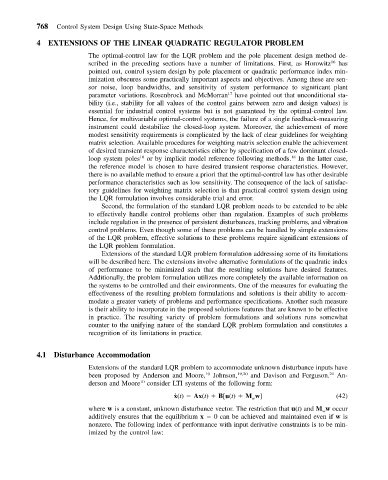Page 777 - Mechanical Engineers' Handbook (Volume 2)
P. 777
768 Control System Design Using State-Space Methods
4 EXTENSIONS OF THE LINEAR QUADRATIC REGULATOR PROBLEM
The optimal-control law for the LQR problem and the pole placement design method de-
scribed in the preceding sections have a number of limitations. First, as Horowitz 16 has
pointed out, control system design by pole placement or quadratic performance index min-
imization obscures some practically important aspects and objectives. Among these are sen-
sor noise, loop bandwidths, and sensitivity of system performance to significant plant
parameter variations. Rosenbrock and McMorran 17 have pointed out that unconditional sta-
bility (i.e., stability for all values of the control gains between zero and design values) is
essential for industrial control systems but is not guaranteed by the optimal-control law.
Hence, for multivariable optimal-control systems, the failure of a single feedback-measuring
instrument could destabilize the closed-loop system. Moreover, the achievement of more
modest sensitivity requirements is complicated by the lack of clear guidelines for weighting
matrix selection. Available procedures for weighting matrix selection enable the achievement
of desired transient response characteristics either by specification of a few dominant closed-
loop system poles 10 or by implicit model reference following methods. 18 In the latter case,
the reference model is chosen to have desired transient response characteristics. However,
there is no available method to ensure a priori that the optimal-control law has other desirable
performance characteristics such as low sensitivity. The consequence of the lack of satisfac-
tory guidelines for weighting matrix selection is that practical control system design using
the LQR formulation involves considerable trial and error.
Second, the formulation of the standard LQR problem needs to be extended to be able
to effectively handle control problems other than regulation. Examples of such problems
include regulation in the presence of persistent disturbances, tracking problems, and vibration
control problems. Even though some of these problems can be handled by simple extensions
of the LQR problem, effective solutions to these problems require significant extensions of
the LQR problem formulation.
Extensions of the standard LQR problem formulation addressing some of its limitations
will be described here. The extensions involve alternative formulations of the quadratic index
of performance to be minimized such that the resulting solutions have desired features.
Additionally, the problem formulation utilizes more completely the available information on
the systems to be controlled and their environments. One of the measures for evaluating the
effectiveness of the resulting problem formulations and solutions is their ability to accom-
modate a greater variety of problems and performance specifications. Another such measure
is their ability to incorporate in the proposed solutions features that are known to be effective
in practice. The resulting variety of problem formulations and solutions runs somewhat
counter to the unifying nature of the standard LQR problem formulation and constitutes a
recognition of its limitations in practice.
4.1 Disturbance Accommodation
Extensions of the standard LQR problem to accommodate unknown disturbance inputs have
been proposed by Anderson and Moore, 10 Johnson, 19,20 and Davison and Ferguson. 21 An-
derson and Moore consider LTI systems of the following form:
10
˙ x(t) Ax(t) B[u(t) Mw] (42)
w
where w is a constant, unknown disturbance vector. The restriction that u(t) and M w occur
w
additively ensures that the equilibrium x 0 can be achieved and maintained even if w is
nonzero. The following index of performance with input derivative constraints is to be min-
imized by the control law:

